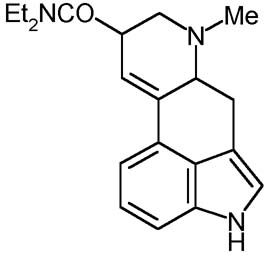DESCRIPTION
Lysergic Acid Diethylamide more commonly known as LSD, is one of the most powerful hallucinogenic drugs known.(See drugabuse).
It was invented in 1938 by the Swiss chemist, Albert Hoffman, who was interested in developing medicines from compounds in ergot, a fungus that attacks rye. Although LSD is purely synthetic, clues to its biological activity can be found by tracing the history of the fungus from which it is derived.

BIOLOGICAL EFFECTS
The mechanism by which LSD causes such profound affects on the human perception still hasn't been established. What is known, is that as well as the uterine-constricting activity mentioned earlier, LSD stimulates centers of the sympathetic nervous system in the midbrain, which leads to pupillary dilation, increase in body temperature, and rise in the blood-sugar level. LSD also has a serotonin-blocking effect. Serotonin is a hormone-like substance, occurring naturally in various organs of warm-blooded animals. Concentrated in the midbrain, it plays an important role in the propagation of impulses in certain nerves and therefore in the biochemistry of psychic functions. LSD also influences neurophysiological functions that are connected with dopamine, which is another naturally occurring hormone-like substance. Most of the brain centres receptive to dopamine become activated by LSD, while the others are depressed. The structure of LSD is very similar to other hallucinogenic drugs such as mescaline and psilocybin, all of which contain a substituted indole ring (or a related structure).
See EFFECTS
PHARMACOKINETICS
LSD's effects normally last from 6–12 hours depending on dosage, tolerance, body weight and age.
LSD affects a large number of the G protein coupled receptors, including all dopamine receptor subtypes, all adrenoreceptor subtypes as well as many others. LSD binds to most serotonin receptor subtypes except for 5-HT3 and 5-HT4. However, most of these receptors are affected at too low affinity to be activated by the brain concentration of approximate 10-20 nM. Recreational doses of LSD can affect 5-HT1A, 5-HT2A, 5-HT2C, 5-HT5A, 5-HT5 B and 5-HT6. The hallucinogenic effects of LSD are attributed to its strong partial agonist effects at 5-HT2A receptors as specific 5-HT2A agonist drugs are hallucinogenic and largely 5-HT2A specific antagonists block the hallucinogenic activity of LSD. Exactly how this produces the drug’s effects is unknown, but it is thought that it works by increasing glutamate release and hence excitation in the cortex, specifically in layers IV and V. In the later stages, LSD acts through DARPP-32 - related pathways that are likely the same for multiple drugs including Cocaine, amphetamine, nicotine, caffeine, PCP, ethanol and morphine. A particularly compelling look at the actions of LSD was performed by Barry Jacobs recording from electrodes implanted into cat raphe nuclei. Behaviorally relevant doses of LSD result in a complete blockade of action potential activity in the dorsal raphe, effectively shutting off the principal endogenous source of serotonin to the telencephalon.
